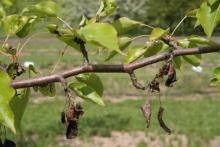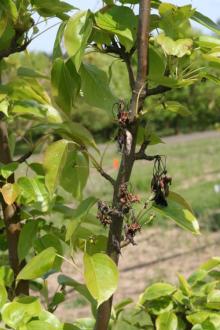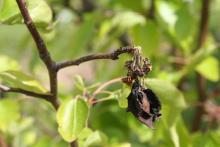See:
Pear (Pyrus spp.) - Pseudomonas Blossom Blast and Dieback
Pear, Asian Cultivar Susceptibility
Cause The bacterium Pseudomonas syringae pv. syringae is much more severe on Asian pear cultivars (Pyrus pyrifolia and P. ussuriensis) than on European pears (P. communis) in western Oregon. This is due in part to the earlier bloom season for Asian pears. Early blooming trees are also more likely to be damaged by spring frosts, which provide an infection route for the bacteria. The cold, wet weather during spring is ideal for spread of the bacteria. Young, vigorously growing trees are more susceptible than older trees. Also, trees with a heavy bloom appear to be more prone to blossom blast than trees with fewer blossoms. Dormant pruning during cold, wet weather may allow the bacteria to enter wounded stems, resulting in stem dieback. Although the bacteria survive on the outside of the plant they must get inside and multiply in the space between plant cells (apoplast) to cause disease. These pathogenic bacteria inject several proteins and small-molecule toxins to get past host immune mechanisms. Once inside, the bacteria induce a watery, nutrient rich environment between the plant cells where they can multiply and continue colonization of the plant tissues. Bacteria also produce a protein that acts as an ice nucleus, increasing frost wounds that bacteria easily colonize and expand.
The Chinese cultivars (P. ussuriensis selections) Hang Pa Li, Hansen Siberian, Harbin, Mien Suan Li, Ping Ding Li, and Shu Li are very prone to frost damage and dieback symptoms. The Chinese white pear cultivars Ya Li and Tse Li are somewhat resistant even when damaged by frost. The Japanese cultivars Hosui, Kosui, and Shinseiki are very susceptible to blossom blast and prone to stem dieback. The cultivar Nijisseiki (20th Century) is less susceptible.
Symptoms While Pseudomonas typically causes only a blossom blast in European pears and rarely spreads into the wood, blossom blast in Asian pears often runs down the stem, killing entire branches. Shoots become water soaked and then turn black as the bacteria move down the stem. Young trees may be killed to the ground.
Cultural control
- Prune Asian pears during dry periods in the winter, or delay pruning until spring or summer. Summer pruning also helps slow down overly vigorous trees.
- Thinning flower spurs during dry periods reduces bloom, helps improve fruit size, and may reduce the amount of disease observed.
- Avoid planting Asian pears in frost pockets or low-lying areas.
- Do not fertilize late in the growing season or encourage late-season growth, which is more susceptible to winter injury.
- Remove and destroy infected branches.
Chemical control Resistance to the active ingredients in these products has been detected in the Pacific Northwest. Limit the use of any one group during crop production.
- Champ WG at 12 to 16 lb/A before fall rains and again before spring growth starts. Excessive dosages may russet fruit. Group M1 fungicide. 48-hr reentry.
- Cuprofix Ultra 40 Disperss at 7.5 to 10 lb/A. Group M1 fungicide. 48-hr reentry.
- Kocide 50 DF at 8 to 12 lb/A before fall rains and again before spring growth starts. Excessive dosages may russet fruit. Group M1 fungicide. 48-hr reentry.
- Nu-Cop 50 DF at 12 to 16 lb/A. May russet fruit. Group M1 fungicide. 48-hr reentry.
- Streptomycin or oxytetracycline applied at early bloom to control fire blight helps control Pseudomonas blossom blast. There are several registered trade names for products that contain streptomycin sulfate including Agri-Mycin, Harbour, and FireWall. 12-hr reentry.
Note: Some cultivars like 'Hosui' are sensitive to oils, especially after bloom. Do not use oils directly or as surfactants during the growing season. 'Yoinashi' and 'Shinko' may also be sensitive.
Reference Scheck, H.J., Pscheidt, J.W., and Moore, L.W. 1996. Copper and streptomycin resistance in strains of Pseudomonas syringae from Pacific Northwest nurseries. Plant Disease 80:1034-1039.




